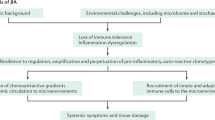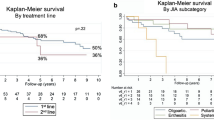Abstract
A number of studies published over the past 10 years have examined the long-term health, functional and quality of life outcomes of adults with childhood-onset rheumatic diseases such as juvenile idiopathic arthritis, systemic lupus erythematosus, juvenile dermatomyositis and localized scleroderma. As increasing numbers of patients with these conditions survive into adulthood, understanding the adult outcomes of these pediatric conditions has become ever-more important. Identifying modifiable risk factors for poor outcomes is vital to improving care for these patients. In addition, as these conditions and their treatments can affect cardiovascular health, bone health and fertility, particular attention needs to be paid to these outcomes. Preparing patients and their families for a successful transition from pediatric to adult rheumatology care is an important first-step in the long-term management strategy for this expanding patient population.
Key Points
-
Understanding the long-term morbidity and mortality of childhood-onset rheumatic diseases is critical to improving outcomes
-
Existing studies have demonstrated that patients with childhood-onset rheumatic diseases are at increased risk of early morbidity and disability
-
It is essential that pediatric patients with a chronic rheumatic disease have a seamless transition from pediatric to adult rheumatology care
-
Prospective, longitudinal studies are needed to better characterize the outcomes of childhood-onset rheumatic diseases
This is a preview of subscription content, access via your institution
Access options
Subscribe to this journal
Receive 12 print issues and online access
$209.00 per year
only $17.42 per issue
Buy this article
- Purchase on Springer Link
- Instant access to full article PDF
Prices may be subject to local taxes which are calculated during checkout
Similar content being viewed by others
References
Minden, K. Adult outcomes of patients with juvenile idiopathic arthritis. Horm. Res. 72 (Suppl. 1), 20–25 (2009).
Cassidy, J. T. & Petty, R. E. Textbook of Pediatric Rheumatology 5th edn (Elsevier Saunders, Philadelphia, 2005).
Bandeira, M. et al. Relationship between damage accrual, disease flares and cumulative drug therapies in juvenile-onset systemic lupus erythematosus. Lupus 15, 515–520 (2006).
Brunner, H. I. et al. Difference in disease features between childhood-onset and adult-onset systemic lupus erythematosus. Arthritis Rheum. 58, 556–562 (2008).
Brunner, H. I. et al. Risk factors for damage in childhood-onset systemic lupus erythematosus: cumulative disease activity and medication use predict disease damage. Arthritis Rheum. 46, 436–444 (2002).
Hersh, A. O. et al. Differences in long-term disease activity and treatment of adult patients with childhood- and adult-onset systemic lupus erythematosus. Arthritis Rheum. 61, 13–20 (2009).
Ravelli, A., Ruperto, N. & Martini, A. Outcome in juvenile onset systemic lupus erythematosus. Curr. Opin. Rheumatol. 17, 568–573 (2005).
Tucker, L. B. et al. Adult- and childhood-onset systemic lupus erythematosus: a comparison of onset, clinical features, serology, and outcome. Br. J. Rheumatol. 34, 866–872 (1995).
Tucker, L. B. et al. Adolescent onset of lupus results in more aggressive disease and worse outcomes: results of a nested matched case–control study within LUMINA, a multiethnic US cohort (LUMINA LVII). Lupus 17, 314–322 (2008).
Alarcón, G. S. et al. Systemic lupus erythematosus in three ethnic groups. VII [correction of VIII]. Predictors of early mortality in the LUMINA cohort. LUMINA Study Group. Arthritis Rheum. 45, 191–202 (2001).
Chalom, E. C. et al. Educational, vocational and socioeconomic status and quality of life in adults with childhood-onset SLE. Pediatr. Rheumatol. Online J. 2, 207–226 (2004).
Gonzalez, B. et al. Changes in the survival of patients with systemic lupus erythematosus in childhood: 30 years experience in Chile. Lupus 14, 918–923 (2005).
Miettunen, P. M. et al. Gender and ethnic origin have no effect on longterm outcome of childhood-onset systemic lupus erythematosus. J. Rheumatol. 31, 1650–1654 (2004).
Wang, L. C. et al. Retrospective analysis of mortality and morbidity of pediatric systemic lupus erythematosus in the past two decades. J. Microbiol. Immunol. Infect. 36, 203–208 (2003).
Hersh, A. O. et al. Childhood-onset disease as a predictor of mortality in an adult cohort of patients with systemic lupus erythematosus. Arthritis Care Res. (Hoboken) 62, 1152–1159 (2010).
Sanner, H. et al. Cumulative organ damage and prognostic factors in juvenile dermatomyositis: a cross-sectional study median 16.8 years after symptom onset. Rheumatology (Oxford) 48, 1541–1547 (2009).
Peterson, L. S., Nelson, A. M. & Su, W. P. Classification of morphea (localized scleroderma). Mayo Clin. Proc. 70, 1068–1076 (1995).
Peterson, L. S. et al. The epidemiology of morphea (localized scleroderma) in Olmsted County 1960–1993. J. Rheumatol. 24, 73–80 (1997).
Li, S. C. et al. Treatment of pediatric localized scleroderma: results of a survey of North American pediatric rheumatologists. J. Rheumatol. 37, 175–181 (2010).
Baildam, E. M. et al. Influence of childhood scleroderma on physical function and quality of life. J. Rheumatol. 38, 167–173 (2011).
Palmero, M. L. et al. En coup de sabre scleroderma and Parry–Romberg syndrome in adolescents: surgical options and patient-related outcomes. J. Rheumatol. 37, 2174–2179 (2010).
Saxton-Daniels, S. & Jacobe, H. T. An evaluation of long-term outcomes in adults with pediatric-onset morphea. Arch. Dermatol. 146, 1044–1045 (2010).
Flato, B. et al. The influence of patient characteristics, disease variables, and HLA alleles on the development of radiographically evident sacroiliitis in juvenile idiopathic arthritis. Arthritis Rheum. 46, 986–994 (2002).
Pagnini, I. et al. Early predictors of juvenile sacroiliitis in enthesitis-related arthritis. J. Rheumatol. 37, 2395–2401 (2010).
Stoll, M. L. et al. Spondyloarthritis in a pediatric population: risk factors for sacroiliitis. J. Rheumatol. 37, 2402–2408 (2010).
Flato, B. et al. Long-term outcome and prognostic factors in enthesitis-related arthritis: a case–control study. Arthritis Rheum. 54, 3573–3582 (2006).
Minden, K. et al. Long-term outcome in patients with juvenile idiopathic arthritis. Arthritis Rheum. 46, 2392–2401 (2002).
Petty, R. E. et al. Revision of the proposed classification criteria for juvenile idiopathic arthritis: Durban, 1997. J. Rheumatol. 25, 1991–1994 (1998).
Flato, B. et al. Juvenile psoriatic arthritis: longterm outcome and differentiation from other subtypes of juvenile idiopathic arthritis. J. Rheumatol. 36, 642–650 (2009).
Asanuma, Y. et al. Premature coronary-artery atherosclerosis in systemic lupus erythematosus. N. Engl. J. Med. 349, 2407–2415 (2003).
Duran, S., Gonzalez, L. A. & Alarcon, G. S. Damage, accelerated atherosclerosis, and mortality in patients with systemic lupus erythematosus: lessons from LUMINA, a multiethnic US cohort. J. Clin. Rheumatol. 13, 350–353 (2007).
Salmon, J. E. & Roman, M. J. Subclinical atherosclerosis in rheumatoid arthritis and systemic lupus erythematosus. Am. J. Med. 121 (10 Suppl. 1): S3–S8 (2008).
Falaschi, F. et al. Nephrotic-range proteinuria, the major risk factor for early atherosclerosis in juvenile-onset systemic lupus erythematosus. Arthritis Rheum. 43, 1405–1409 (2000).
Huang, Y. L. et al. Lymphopenia is a risk factor in the progression of carotid intima–media thickness in juvenile-onset systemic lupus erythematosus. Arthritis Rheum. 60, 3766–3775 (2009).
Ardoin, S. P. et al. Laboratory markers of cardiovascular risk in pediatric SLE: the APPLE baseline cohort. Lupus 19, 1315–1325 (2010).
Schanberg, L. E. et al. Premature atherosclerosis in pediatric systemic lupus erythematosus: risk factors for increased carotid intima–media thickness in the Atherosclerosis Prevention in Pediatric Lupus Erythematosus cohort. Arthritis Rheum. 60, 1496–1507 (2009).
Schanberg, L. E. et al. Does atorvastatin reduce progression of carotid intimal medial thickening (CIMT) in childhood SLE? Results from the Atherosclerosis Prevention in Pediatric Lupus (APPLE) trial: a multicenter, randomized, double-blind placebo-controlled study [abstract 1677]. Arthritis Rheum. 62 (Suppl.), S699 (2010).
Cimaz, R. Osteoporosis in childhood rheumatic diseases: prevention and therapy. Best Pract. Res. Clin. Rheumatol. 16, 397–409 (2002).
Hamalainen, H. et al. Bone mineral content in young adults with active or inactive juvenile idiopathic arthritis and in controls. Scand. J. Rheumatol. 39, 219–222 (2010).
Haugen, M. et al. Young adults with juvenile arthritis in remission attain normal peak bone mass at the lumbar spine and forearm. Arthritis Rheum. 43, 1504–1510 (2000).
Lilleby, V. et al. Frequency of osteopenia in children and young adults with childhood-onset systemic lupus erythematosus. Arthritis Rheum. 52, 2051–2059 (2005).
Aikawa, N. E. et al. Menstrual and hormonal alterations in juvenile dermatomyositis. Clin. Exp. Rheumatol. 28, 571–575 (2010).
Packham, J. C. & Hall, M. A. Premature ovarian failure in women with juvenile idiopathic arthritis (JIA). Clin. Exp. Rheumatol. 21, 347–350 (2003).
Brunner, H. I. et al. Disease outcomes and ovarian function of childhood-onset systemic lupus erythematosus. Lupus 15, 198–206 (2006).
Medeiros, P. B. et al. Menstrual and hormonal alterations in juvenile systemic lupus erythematosus. Lupus 18, 38–43 (2009).
Silva, C. A. & Brunner, H. I. Gonadal functioning and preservation of reproductive fitness with juvenile systemic lupus erythematosus. Lupus 16, 593–599 (2007).
Ostlie, I. L., Dale, O. & Möller, A. From childhood to adult life with juvenile idiopathic arthritis (JIA): a pilot study. Disabil. Rehabil. 29, 445–452 (2007).
Hazel, E. et al. High rates of unsuccessful transfer to adult care among young adults with juvenile idiopathic arthritis. Pediatr. Rheumatol. Online J. 8, 2 (2010).
Hilderson, D. et al. Adolescents with juvenile idiopathic arthritis: who cares after the age of 16? Clin. Exp. Rheumatol. 28, 790–797 (2010).
Hersh, A. O. et al. The challenges of transferring chronic illness patients to adult care: reflections from pediatric and adult rheumatology at a US academic center. Pediatr. Rheumatol. Online J. 7, 13 (2009).
Acknowledgements
Dr. Hersh's research on the adult outcomes of childhood-onset rheumatic disease is generously supported by the American College of Rheumatology Research and Education Foundation Rheumatology Investigator Award. C. P. Vega, University of California, Irvine, CA, is the author of and is solely responsible for the content of the learning objectives, questions and answers of the Medscape, LLC-accredited continuing medical education activity associated with this article.
Author information
Authors and Affiliations
Contributions
A. Hersh researched data for and wrote the article. All authors made substantial contributions to discussion of the content and to review/editing of the manuscript before submission.
Corresponding author
Ethics declarations
Competing interests
The authors declare no competing financial interests.
Rights and permissions
About this article
Cite this article
Hersh, A., von Scheven, E. & Yelin, E. Adult outcomes of childhood-onset rheumatic diseases. Nat Rev Rheumatol 7, 290–295 (2011). https://doi.org/10.1038/nrrheum.2011.38
Published:
Issue Date:
DOI: https://doi.org/10.1038/nrrheum.2011.38
This article is cited by
-
Efficacy and safety of TNF inhibitors in the treatment of juvenile idiopathic arthritis: a systematic literature review
Pediatric Rheumatology (2023)
-
Transition readiness in adolescents and young adults with chronic rheumatic disease in Oman: today’s needs and future challenges
Pediatric Rheumatology (2022)
-
Health-related quality of life, continuity of care and patient satisfaction: long-term outcomes of former patients of the Tuebingen Transition Program (TTP) – a retrospective cohort study
Pediatric Rheumatology (2022)
-
Longitudinal assessment of preparation for care transition among adolescents and young adults with rheumatologic disease: a single-center pilot study
Pediatric Rheumatology (2022)
-
Assessment of transition readiness in adolescents in Thailand with rheumatic diseases: a cross-sectional study
Pediatric Rheumatology (2021)



